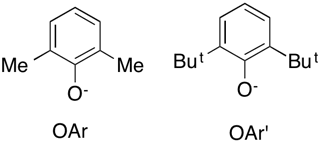Aryloxides of Eu(II) and Yb(II)

Eu(II) and Yb(II) are larger than their corresponding Ln(III) ions. This makes it more of a challenge to achieve coordinative saturation, especially given the reduced charge and therefore the reduced number of uni-negative ligands that are required for a neutral complex.
[Eu3(OAr)6(thf)6] achieves a c.n of 6 through bridging OAr ligands and coordination of thf.
Yb(II) is smaller than Eu(II) and a c.n. of 3 is achieved in [Yb2(OAr')4] (note that Ar' has But substituents)
[Ce2(OiPr)4(iPrOH)2]
Ce is the only lanthanide that has a +4 oxidation stte accessible in solution. The radius of Ce(IV) is smaller than that of Ce(III). Ce(IV) has a c.n. of 6 in [Ce2(OiPr)4(iPrOH)2]